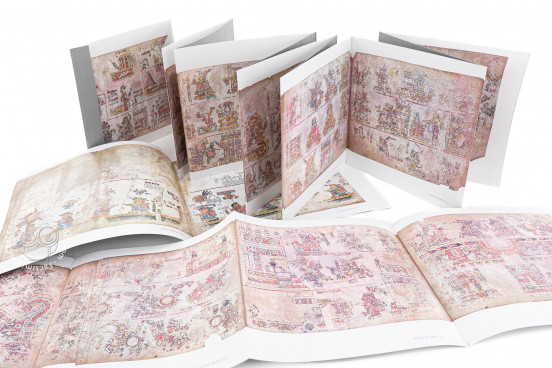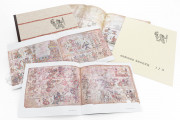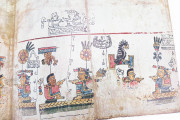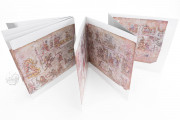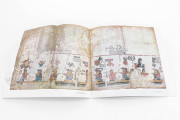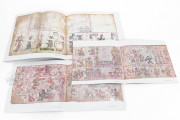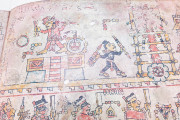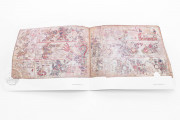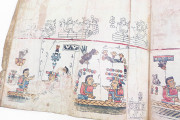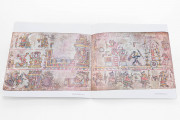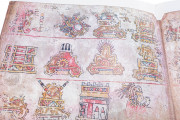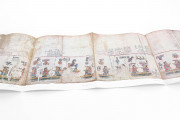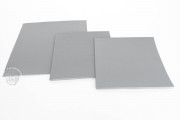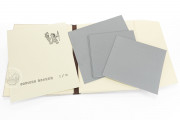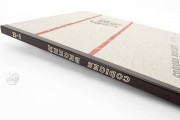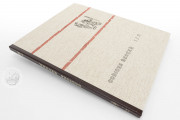Despite their nicknames, Codices Becker I and II are not composed of folded sheets sewn at a spine. They are a pair of screenfold manuscripts, both fragments of Mixtec objects in the preconquest style from Oaxaca, Mexico. Becker I dates from before the Spanish arrived in Mexico in 1519, and Becker II was manufactured in the colonial period in a pre-Hispanic style.
Containing illustrations and polychrome pictographs relating to rulers of Mixtec city-states, together the manuscripts provide a historical record of ancestral alliances and divine lineages of leading families. Becker I contains sixteen panels (18.5 x 25 cm) and Becker II five panels (21.2 x 28.9 cm), with the figures and pictographs painted on one side.
Rare Survivals
The three fragments that comprise Becker I, a total of 396.4 cm in length, together with twenty-four panels preserved in the Museo Nacional de Anthropología in Mexico City, constitute the surviving panels of the screenfold known as the Codex Colombino-Becker. Colombino-Becker is a pictorial history of the Mixtec ruler Lord Eight Deer "Jaguar Claw" (1063-1115 CE) and his wife Lady Six Monkey, with the protagonists identified by pictographs. The manuscript relates Eight Deer's rise to the position of cacique (chieftain), highlighting military triumphs and a visit to the underworld, as well as political intrigues that led to his murder.
A number of its illustrations have been deliberately mutilated. Panel 13 is completely filled with pictographs of place names. The original content of Becker II, 115.6 cm in length, is a series of portraits of caciques in ceremonial regalia and their spouses seated on mats, with the individuals identified by pictographs. More figures and pictographs were added early in the object's history. The "Nochistlán Fragment" in the Museum für Völkerkunde in Hamburg was once the first portion of this screenfold. The leaders identified in Becker II have not been found in the other genealogies in the Mixtec Group, which includes the Codex Zouche-Nuttall and the Codex Yuta Tnoho.
Two Fragments, One Pictograph Tradition
Codices Becker I and II are fragments of two manuscripts probably manufactured generations apart. Despite this chronological separation, the illustrations of both were carried out in the traditional Mesoamerican pictographic tradition with richly detailed images of figures, architecture, animals, costume, and objects outlined in black. The supports differ slightly. Becker I was fashioned from seven strips of deerskin and agave fibers covered in a thin layer of plaster. The substrate for Becker II is made up two strips of deerskin covered with plaster.
The palette of Becker I is dominated by red and ocher, with some green; the palette of Becker II is dominated by red, ocher, and a light blue. The panels are composed in registers designed to lead the reader through the storyline by dividing the space using straight red lines. Most of the panels of Becker I have pictographs in three registers, and the original content of Becker II is confined to a single register occupying the bottom half of each panel.
From Puebla to Vienna
The two fragments are named after the Darmstadt businessman, Philipp J. Becker (1820-1895), who lived and worked in Puebla, Mexico for some twenty years in the mid-nineteenth century. Becker I had been in the collection of Manuel Cardozo (d. 1869). It was acquired from Cardozo's estate by Alfredo Chavero, who sold it to Francisco Iturbe. It was briefly in the possession of José María Pérez Hernández, before it fell into Becker's hands at some time before 1872. The whereabouts of Becker II are unknown before being documented in Becker's collection in 1872. In 1897, Georg Haas (1841-1914) acquired Becker's substantial collection of Mexican antiquities for the k.k. Naturhistorisches Hofmuseum, later (1928) renamed the Museum für Völkerkunde, known since 2014 as the Weltmuseum.
We have 1 facsimile edition of the manuscript "Codices Becker I/II": Codices Becker I/II facsimile edition, published by Akademische Druck- u. Verlagsanstalt (ADEVA), 1961
Request Info / Price
